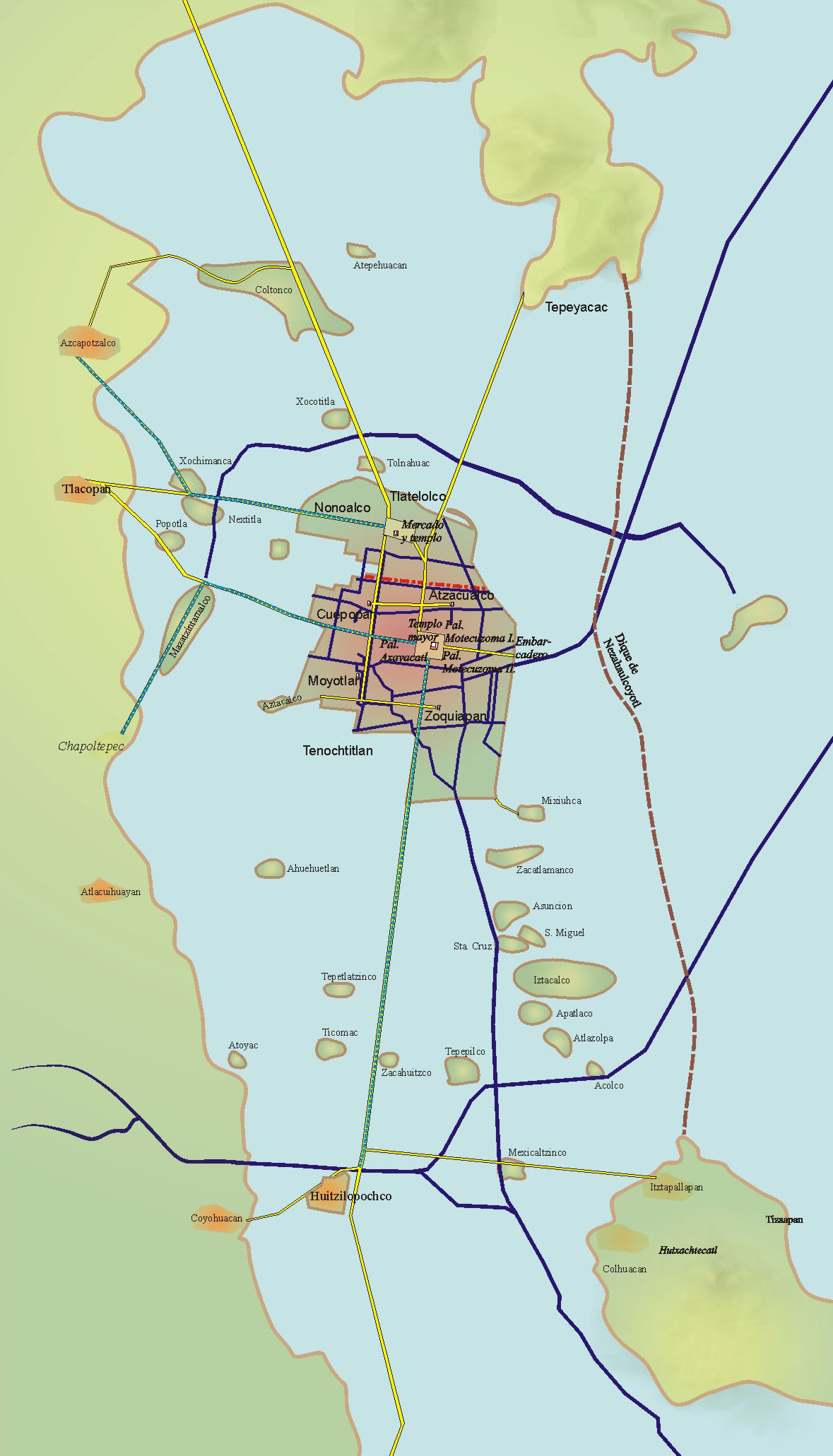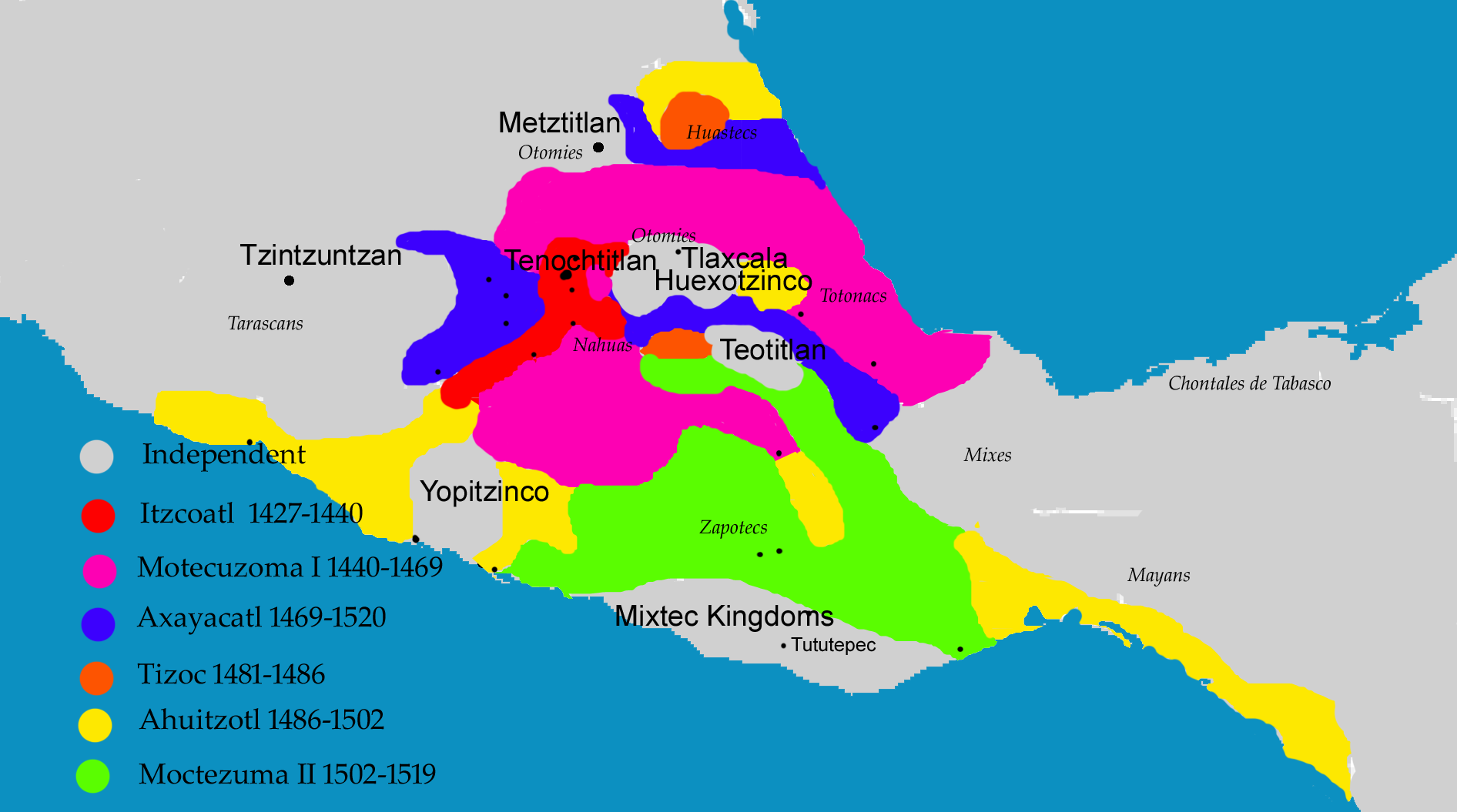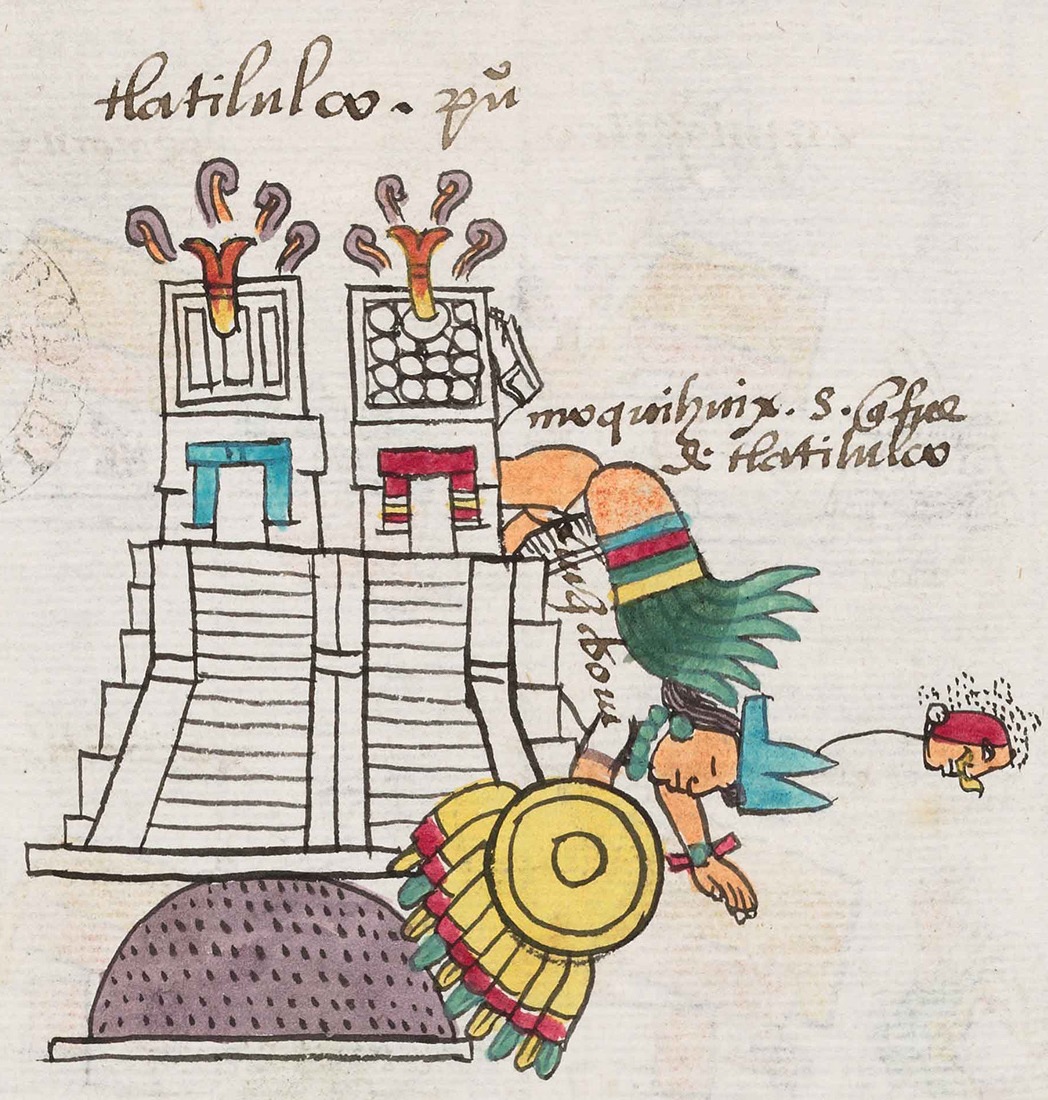|
Tzintzuntzan, Michoacán
Tzintzuntzan () is a town in Tzintzuntzan Municipality located in the north of Michoacán state, 53 km from the capital of Morelia and 17.5 km from Pátzcuaro, located on the northeast shore of Lake Pátzcuaro. It is best known as the former capital of the Tarascan state until it was conquered by the Spanish in the 1520s. Today, Tzintzuntzan is a small town with two major attractions, the archeological site of Tzintzuntzan and the former monastery complex of San Francisco. The municipality contains another important archeological site called Ihuatzio. It is also notable for its festivals, which include the Festival of Señor del Rescate, Day of the Dead celebrations and a cultural event related to New Year's. History The name ''Tzintzuntzan'' comes from the Purépecha language, meaning "place of the hummingbirds". The Purépecha had a god named Tzintzuuquixu, meaning "hummingbird of the south", which, like the Mexica to Tenochtitlán, was involved in guiding the tribe ... [...More Info...] [...Related Items...] OR: [Wikipedia] [Google] [Baidu] |
States Of Mexico
A Mexican State (), officially the Free and Sovereign State (), is a constituent Federated state, federative Polity, entity of Mexico according to the Constitution of Mexico. Currently there are 31 states, each with its own constitution, State governments of Mexico, government, Lists of Mexican state governors, state governor, and List of Mexican state congresses, state congress. In the hierarchy of Administrative divisions of Mexico, Mexican administrative divisions, states are further divided into municipalities of Mexico, municipalities. Currently there are 2,462 municipalities in Mexico. Although not formally a state, political reforms have enabled Mexico City (), the capital city of the Mexico, United Mexican States to have a federative entity status equivalent to that of the states since January 29, 2016. Current Mexican governmental publications usually lists 32 federative entities (31 states and Mexico City), and 2,478 municipalities (including the 16 boroughs of Mexico ... [...More Info...] [...Related Items...] OR: [Wikipedia] [Google] [Baidu] |
Tenochtitlán
, also known as Mexico-Tenochtitlan, was a large Mexican in what is now the historic center of Mexico City. The exact date of the founding of the city is unclear, but the date 13 March 1325 was chosen in 1925 to celebrate the 600th anniversary of the city. The city was built on an island in what was then Lake Texcoco in the Valley of Mexico. The city was the capital of the expanding Aztec Empire in the 15th century until it was captured by the Tlaxcaltec and the Spanish in 1521. At its peak, it was the largest city in the pre-Columbian Americas. It subsequently became a '' cabecera'' of the Viceroyalty of New Spain. Today, the ruins of are in the historic center of the Mexican capital. The World Heritage Site of contains what remains of the geography (water, boats, floating gardens) of the Mexica capital. was one of two Mexica (city-states or Polity, polities) on the island, the other being . Etymology Traditionally, the name was thought to come from Nahuatl ( ... [...More Info...] [...Related Items...] OR: [Wikipedia] [Google] [Baidu] |
Quiroga, Michoacán
Quiroga is a municipality in the Mexican state of Michoacán. The municipal seat of Quiroga is also called Quiroga. Geography The municipality of Quiroga is located at the north of the State, at coordinates 19° 40 'N latitude and 101° 32' west. At an altitude of 2080 meters above sea level. Coeneo bordered on the north, east to Morelia, on the south by Tzintzuntzan, and on the west by Erongarícuaro. Its distance from the State capital is 45 km(27.96 miles). Quiroga has an area of 211.52 square kilometers, accounting for 0.35 percent of total state. Climate The climate is mild, with rain in the summer. It has an annual rainfall of 788.6 cubic millimeters and temperatures ranging from 5.0 to 25.0 °C. Political structure The municipal president is the chairman of the city council and represents the municipality to the state and federal government, promoting rules and statutes for the proper operation and control of life of the inhabitants of the municipality of Q ... [...More Info...] [...Related Items...] OR: [Wikipedia] [Google] [Baidu] |
Mexican War Of Independence
The Mexican War of Independence (, 16 September 1810 – 27 September 1821) was an armed conflict and political process resulting in Mexico's independence from the Spanish Empire. It was not a single, coherent event, but local and regional struggles that occurred within the same period, and can be considered a List of wars of independence, revolutionary civil war. It culminated with the drafting of the Declaration of Independence (Mexico), Declaration of Independence of the Mexican Empire in Mexico City on September 28, 1821, following the collapse of royal government and the military triumph of forces for independence. Mexican independence from Spain was not an inevitable outcome of the relationship between the Spanish Empire and its most valuable overseas possession, but events in Spain had a direct impact on the outbreak of the armed insurgency in 1810 and the course of warfare through the end of the conflict. Napoleon, Napoleon Bonaparte's Peninsular War, invasion of Spa ... [...More Info...] [...Related Items...] OR: [Wikipedia] [Google] [Baidu] |
Vasco De Quiroga
Vasco de Quiroga (1470/78 – 14 March 1565) was the first bishop of Michoacán, Mexico, and one of the judges ('' oidores'') in the second Real Audiencia of Mexico – the high court that governed New Spain – from January 10, 1531, to April 16, 1535. Coming from a background as a lawyer and a judge he was appointed to be a judge in the second Audiencia after the first Audiencia's failure. As an ''oidor'' he took a strong interest in restoring order to the Michoacán area which had been ravaged by rebellions and unrest. He employed a strategy of congregating indigenous populations into congregated Hospital-towns called ''Republicas de Indios'', organized after principles derived from Thomas More's ''Utopia''. The purpose of this policy was to teach the Indians a trade and to instruct them in Christian values and lifestyles. He established multiple such hospitals: Santa Fé de México close to the town of Tacubaya in the Valley of Mexico, and Santa Fé de la Laguna close to ... [...More Info...] [...Related Items...] OR: [Wikipedia] [Google] [Baidu] |
Nuño De Guzmán
Nuño Beltrán de Guzmán (1558) was a Spanish conquistador and colonial administrator in New Spain. He was the governor of the province of Pánuco (province), Pánuco from 1525 to 1533 and of Nueva Galicia from 1529 to 1534, and president of the first Royal Audiencia of Mexico – the high court that governed New Spain – from 1528 to 1530. He founded several cities in Northwestern Mexico, including Guadalajara. Originally a bodyguard of Charles V, Holy Roman Emperor, Charles I of Spain, he was sent to Mexico to counterbalance the influence of the leader of the Spanish conquest of the Aztec Empire, Hernán Cortés, since the King worried he was becoming too powerful. As Governor of Pánuco, Guzmán cracked down hard on the supporters of Cortés, stripping him and his supporters of property and rights. He conducted numerous expeditions of conquest into the northwestern areas of Mexico, enslaving thousands of Indians and shipping them to the Spanish West Indies, Caribbean colonies ... [...More Info...] [...Related Items...] OR: [Wikipedia] [Google] [Baidu] |
Burned At The Stake
Death by burning is an list of execution methods, execution, murder, or suicide method involving combustion or exposure to extreme heat. It has a long history as a form of public capital punishment, and many societies have employed it as a punishment for and warning against crimes such as treason, heresy, and witchcraft. The best-known execution of this type is burning at the stake, where the condemned is bound to a large wooden stake and a fire lit beneath. A holocaust is a religious animal sacrifice that is completely consumed by fire, also known as a burnt offering. The word derives from the ancient Greek holokaustos, the form of sacrifice in which the victim was reduced to ash, as distinguished from an animal sacrifice that resulted in a communal meal. Effects In the process of being burned to death, a body experiences burns to tissue, changes in content and distribution of body fluid, fixation (histology), fixation of tissue, and shrinkage (especially of the skin). Intern ... [...More Info...] [...Related Items...] OR: [Wikipedia] [Google] [Baidu] |
Moctezuma II
Moctezuma Xocoyotzin . ( – 29 June 1520), retroactively referred to in European sources as Moctezuma II, and often simply called Montezuma,Other variant spellings include Moctezuma, Motewksomah, Motecuhzomatzin, Moteuczoma, Motecuhzoma, Motēuczōmah and Muteczuma was the ninth emperor of the Aztec Empire (also known as the Mexica Empire), reigning from 1502 or 1503 to 1520. Through his marriage with Queen Tlapalizquixochtzin of Ecatepec, one of his two wives, he was also the king consort of that ''altepetl''. The first contact between the indigenous civilizations of Mesoamerica and Europeans took place during his reign. He was killed during the initial stages of the Spanish conquest of the Aztec Empire when Hernán Cortés, the Spanish conquistador, and his men seized the Aztecs, Aztec capital of Tenochtitlan. During his reign, the Aztec Empire reached its greatest size. Through warfare, Moctezuma expanded the territory as far south as Soconusco, Xoconosco in Chiapas and the ... [...More Info...] [...Related Items...] OR: [Wikipedia] [Google] [Baidu] |
Ahuizotl
Ahuitzotl (, ) was the eighth Aztec ruler, the '' Huey Tlatoani'' of the city of Tenochtitlan, son of princess Atotoztli II. His name literally means "Water Thorny" and was also applied to the otter. It is also theorized that more likely, the animal called ahuitzotl is actually the water opossum, the hand symbolizing its prehensile tail, which otters notably lack. Either Ahuitzotl or his predecessor Tizoc was the first ''tlatoani'' of Tenochtitlan to assume the title ''Huey Tlatoani'' ("supreme ''tlatoani''") to make their superiority over the other cities in the Triple Alliance (Aztec Empire) clear. Ahuitzotl was responsible for much of the expansion of the Mexica domain, and consolidated the empire's power after emulating his predecessor. He took power as Emperor in the year 7 Rabbit (1486), after the death of his predecessor and brother, Tizoc. He had two sons, the kings Chimalpilli II and Cuauhtémoc, and one daughter. Biography Perhaps the greatest known military leade ... [...More Info...] [...Related Items...] OR: [Wikipedia] [Google] [Baidu] |
Axayacatl
Axayacatl (; ; ; meaning "face of water"; –1481) was the sixth of the of Tenochtitlan and Emperor of the Aztec Triple Alliance. Biography Early life and background Axayacatl was a son of the princess Atotoztli II and her cousin, prince Tezozomoc (son of Itzcoatl), Tezozomoc. He was a grandson of the Emperors Moctezuma I and Itzcoatl. He was a descendant of the king Cuauhtototzin. He was a successor of Moctezuma and his brothers were Emperors Tizoc and Ahuitzotl and his sister was the Queen Chalchiuhnenetzin. He was an uncle of the Emperor Cuauhtémoc and father of Emperors Moctezuma II and Cuitláhuac. Rise to power During his youth, his military prowess gained him the favor influential figures such as Nezahualcoyotl (tlatoani), Nezahualcoyotl and Tlacaelel I, and thus, upon the death of Moctezuma I in 1469, he was chosen to ascend to the throne, much to the displeasure of his two older brothers, Tizoc and Ahuitzotl. It is also important that the Aztec calendar stone, ... [...More Info...] [...Related Items...] OR: [Wikipedia] [Google] [Baidu] |
Aztec
The Aztecs ( ) were a Mesoamerican civilization that flourished in central Mexico in the Post-Classic stage, post-classic period from 1300 to 1521. The Aztec people included different Indigenous peoples of Mexico, ethnic groups of central Mexico, particularly those groups who spoke the Nahuatl, Nahuatl language and who dominated large parts of Mesoamerica from the 14th to the 16th centuries. Aztec culture was organized into city-states (''altepetl''), some of which joined to form alliances, political confederations, or empires. The Aztec Empire was a confederation of three city-states established in 1427: Tenochtitlan, the capital city of the Mexica or Tenochca, Tetzcoco (altepetl), Tetzcoco, and Tlacopan, previously part of the Tepanec empire, whose dominant power was Azcapotzalco (altepetl), Azcapotzalco. Although the term Aztecs is often narrowly restricted to the Mexica of Tenochtitlan, it is also broadly used to refer to Nahuas, Nahua polities or peoples of central Pre ... [...More Info...] [...Related Items...] OR: [Wikipedia] [Google] [Baidu] |






